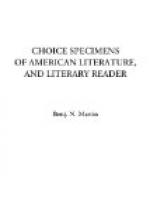[Footnote 67: The age of this meritorious and industrious writer we have not been able to learn. The second edition of his book on Wisconsin appeared in 1846.]
* * * * *
=_264._= ANCIENT EARTHWORKS.
There is a class of ancient earthworks in Wisconsin, not before found in any other country.... Some have a resemblance to the buffalo, the eagle, or crane, or to the turtle or lizard. One, representing the human form, near the Blue Mounds, is, according to R.C. Taylor, Esq., one hundred and twenty feet in length: it lies in an east and west direction, the head towards the west, with the arms and legs extended. The body or trunk is thirty feet in breadth, the head twenty-five, and its elevation above the general surface of the prairie is about six feet. Its conformation is so distinct, that there can be no possibility of mistake in assigning it to the human figure.
* * * * *
=_Charles Wilkins Webber, 1819-1856._= (Manual, p. 505.)
From “Wild Scenes and Song-birds.”
=_265._= THE MOCKING-BIRD.
THE next spring a new melody filled the air. A melody such as I had never heard before burst in clear and overwhelming raptures from the meadows where I had first seen the graceful stranger with the white-barred wings, last year.... I saw it now leaping up from its favorite perch on a tree-top much in the manner I had observed before, but now it was in a different mood and seemed to mount thus spirit-like upon the wilder ecstasies, and floating fall upon the subsiding cadence, of that passionate song it poured into the listening ear of love, for I could see his mate, with fainter bars across her wings, where she sat upon a thornbush near, and listened. When this magnificent creature commenced to sing, the very air was burdened with a thousand different notes; but his voice rose clear and melodiously loud above them all. As I listened, one song after another ceased suddenly, until, in a few minutes, and before I could realize that it was so, I found myself hearkening to that solitary voice. This is a positive fact. I looked around me in astonishment. What! Are they awed? But his song only now grew more exulting, and, as if feeling his triumph, he bounded yet higher, with each new gush, and in swift and quivering raptures dived, skimmed, and floated round—round—then rose to fall again more boldly on the billowy storm of sound.




